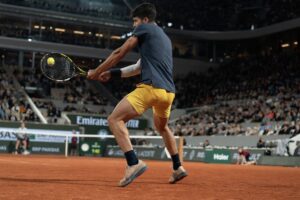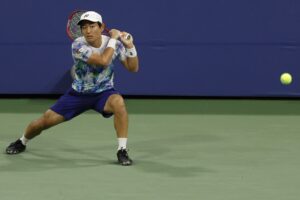Non-devotees of women’s tennis might think that the Fed Cup is a tournament named in honour of the great Roger, but it is, of course, the female equivalent of the Davis Cup, the premier women’s team competition in tennis. Now, under the seemingly inspired leadership of Anne Keothavong, Great Britain stand on the verge of returning to the top tier of the Fed Cup – the World Group, which features the top 16 women’s international teams (divided into two groups of eight).
Having already won their group, GB now face a play-off in Estonia on Sunday against either Hungary or Croatia, and if they win that they will progress through to a final play-off in April, for the right to return to the top table of women’s team tennis. However, even if they do return to the World Group for the first time in many years, they will still have a long way to go to emulate the feats of their forebears, who reached four finals.
BRITAIN’S LOSING FED CUP FINALS
1967 (USA 2, GB 0): The Fed Cup (or the Federation Cup, as it was called from the first edition in 1963 until 1995) differs from the Davis Cup in many ways, not least in its format. Instead of the men’s five-match format, which is played out over a weekend (with the “reverse” singles on the Sunday), a Fed Cup tie is played out over a single day, with two singles matches and a doubles match. Great Britain first reached the final in the fifth year of the tournament, when they played the mighty USA, who were the defending champions.
Played in a “neutral” venue in Berlin (more specifically, West Berlin, as it was then), the American team of the great Billie-Jean King and Rosie Casals, who was a fine player in her own right (she went on to reach two Grand Slam singles finals, at the US Open in 1970 and 1971, but lost both of them), proved too strong for the British pairing, the veteran Ann Jones (who would go on to win Wimbledon in 1969) and the precocious Virginia Wade (who would famously go on to become the last British woman to win Wimbledon in 1977).
After the Americans won the two singles matches in straight sets to take an unassailable 2-0 lead in the best-of-three tie, the American and British women began, but never finished, their doubles match. Unfortunately, this defeat in their first Fed Cup final for the British women set the tone for what was to come.
1971 (AUSTRALIA 3, GB 0): Four years later, Great Britain returned to the final, only to face the other great powerhouse of women’s tennis, Australia. (For most of the 20th century, the USA and Australia dominated both the Davis Cup and the Federation Cup.) On this occasion, all three matches were played and unfortunately Britain lost them all.
First, Virginia Wade, who by then was a Grand Slam champion herself (having won the US Open in 1968), lost to the young Aussie prodigy, Evonne Goolagong, who had won both the French Open and Wimbledon earlier that year. Then, in the battle of the veterans, Ann Jones lost to the great Margaret Court, although Jones at least won a set, winning the first 8-6 (in the era before the tie-break became universally used in tennis). Winnie Shaw, one of Scotland’s finest female players (and one of its finest players of either gender until the advent of the Murray brothers), paired up with Wade in the doubles, but Court and Lesley Hunt were too strong for them and they lost in straight sets.
1972 (South Africa 2, Great Britain 1): The third of Great Britain’s losses in the Fed Cup final (indeed, their third loss in five years) was probably the hardest to bear, because in the 1972 final Britain was the only one of the teams to field a Grand Slam winner, in the form of Virginia Wade. In an extremely rare year in which neither Australia nor the USA made the final, Britain were favourites to finally win a Fed Cup. However, although Wade did her bit by beating Patricia Walkden in straight sets in her singles match, Winnie Shaw, who was playing singles after the retirement of Ann Jones the previous year, succumbed to Brenda Kirk.
It all came down to the deciding doubles match, but the South Africans were both fine doubles players (especially Walkden, who had reached the French Open doubles final in 1967) and won through in straight sets against Wade and Joyce Williams, a relative unknown.
What was perhaps most memorable about this final, though, was that it actually took place in South Africa, before the country was completely banned from international sporting competition for its appalling apartheid regime. South Africa returned to the Fed Cup final the following year, losing to Australia, but it has never gone close since. Indeed, although South African rugby, cricket and even football returned to its former glory after the election of Nelson Mandela and the end of apartheid, South African tennis, especially women’s tennis, has never recaptured its former glory.
1981 (USA 3, GREAT BRITAIN 0): The fourth and final time that Britain reached the Fed Cup final effectively marked the end of what can be seen in retrospect as a Golden Age for British women’s tennis. Even if the national team couldn’t win the Fed Cup, and on this occasion it was again whitewashed by the US, it could still boast two Grand Slam champions in Virginia Wade (who, by 1981, was a veteran herself) and Sue Barker (who had won the French Open in 1976, her lone Major win). There were high hopes that Jo Durie, who played alongside Barker in the doubles, would go on to win a Grand Slam, but of course those hopes were never fulfilled. Indeed, it was only at the end of last year, when Jo Konta reached the World Top 10 for the first time, that Britain could boast even a Top 10 female player for the first time since Durie entered (and quickly vacated) the game’s elite in 1984.
AND THE WEDDING…?
There was a brief period in the late 1970s when it was hoped that Chris Evert’s marriage to Britain’s John Lloyd would somehow make her eligible for the GB Fed Cup team. Alas, Evert was a proud American, who competed in numerous Fed Cup-winning teams, and even if the organisers had allowed her to, she would never have defected to this side of the pond.
However, mention of Evert and Lloyd does prompt one interesting question: why has there never been a mixed doubles equivalent of the Davis or Fed Cups? Alas, the answer is simple. Given how hard it has been over the years to persuade the game’s top players to represent their countries in single-gender competitions (a trend that has sadly gathered pace in recent years), it was always inconceivable that they could be persuaded to play mixed doubles internationally, especially when so few of them ever played it at tour level. Nevertheless, if there had been such a competition, it is hard to think of a finer pairing than Evert and Lloyd, who might well have become “World Mixed Doubles Champions” if there had ever been such an event.
Enjoy articles looking back at all-time best players and tennis history in general? Make sure to check out our page devoted to stories appreciating historic achievements in tennis.
Main Photo:






